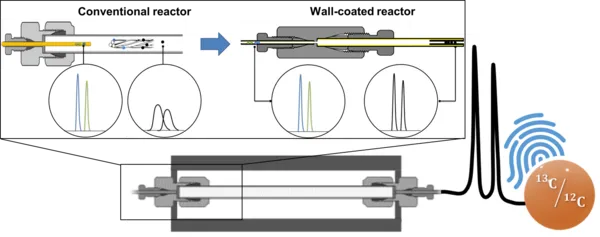Optimizing Peak Resolution for Compound-specific Isotope Analysis (CSIA)

A wall-coated tube specifically designed for online combustion in GC-IRMS aims to minimize peak broadening and facilitate GCxGC-IRMS.
The online combustion of analytes between gas chromatography and isotope ratio mass spectrometry (GC-C-IRMS) has enabled compound-specific isotope analysis (CSIA) for various applications, such as assessment of environmental contaminants or doping in sports. However, CSIA is challenged by the need for complete peak separation and for best sensitivity. Comprehensive gas chromatography could deliver a breakthrough, but hinges on the development of robust miniaturized online combustion tubes that offer sufficient oxidation capacity and catalytic surface area to accomplish complete analyte conversion to CO2, while being narrow enough to preserve narrow analyte peak shapes within the continuous flow carrier stream. The current step change when He carrier gas passes from GC capillary columns (inner diameter, i.d.: 0.22–0.32 mm) to commercial combustion tubes (i.d.: 0.5 mm) generates substantial peak broadening. Even smaller GC capillaries are needed, however, to support GCxGC applications and to improve sensitivity by reducing flows and, therefore, minimizing losses in an open split before IRMS. Since commercial reactor tubes are not compatible with fast GC-C-IRMS and GCxGC-C-IRMS, efforts have been directed at developing alternative miniaturized reactor tubes. To pioneer the necessary dramatic reduction of reactor tube size, a Ni wall-coated catalytic microreactor is constructed by electroless plating. This approach has the benefit of simplicity, while allowing for the fabrication of narrow bore capillary reactors (inner diameter < 0.2 mm), which is not achievable with hand loading of metal wires. The weight of the coating is determined by ICP-MS, while the layer thickness is measured by SEM and EDX. An 18 cm long Ni layer is coated in the middle of a 30.5 cm long quartz (o.d. 1.5 mm, i.d. 0.32 mm) to fit the furnace hot zone. Precise and accurate data were obtained for caffeine, with an overall mean Δδ13C of -0.16‰ and a standard deviation of ±0.12 ‰.